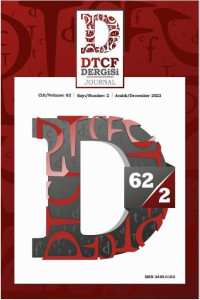NON-MUSLIMS IN THE PERFORMING ARTS IN THE LAST CENTURY OF THE OTTOMAN STATE AND THE FIRST TEN YEARS OF REPUBLIC TURKEY
Abstract
When the performing arts of the Ottoman Turks are mentioned, the first ones that come to mind are “karagöz, ortaoyunu, meddah, puppet, village theatrical plays”. In With the emergence of the theater in the contemporary sense, it has often been discussed whether the spectacle based on the animation within the traditional Turkish theater will be evaluated within the concept of "theatre" and whether the said practices will constitute the infrastructure of the contemporary theatre. In this context, this cultural transformation, which showed its influence on the non-Muslim subjects and their interests, who were closer to the West in the aforementioned state, was again most effective in the field of art. When the XIX.th century was reached, it was revealed by many social studies that the influence of art and artists in the Ottoman intellectual life was great. Based on the aforementioned idea, when the European style contemporary performing arts were mentioned in the Ottoman Empire, the "tuluat", which began as an adaptation of the traditional middle dance style to the modern theater, came into being. Tuluat, as an art that showed its own influence in many areas of social life in the last century of the state, attracted the attention of many groups interested in performing arts in Ottoman society, including non-Muslims. With this study, the place of theater, which is one of the noblest of theatrical arts, in Ottoman culture, the contributions of non-Muslims to it, the arrival of cinema, which is the technically advanced level of the aforementioned art to the Ottoman Empire and the films shot from the day it came to the first years of the Republic, the favor of the non-Muslim population towards the opening and operation of movie theaters, their contributions in the artistic and technical field have been tried to be explained by making use of archive documents.
Keywords
Project Number
yok
References
- Referans1: BOA (Başbakanlık Osmanlı Arşivi). Fon Kodu: A.) MKT.MHM. Dosya: 390, Gömlek: 80 Sıra:1. “Naum Tiyatrosunun Gaz Bedeli”, 09/05/1284.
- Referans 2: BOA. (Başbakanlık Osmanlı Arşivi). Fon Kodu: A.DVN. Dosya: 57, Gömlek: 82, Sıra: 2. “Beyoğlu’nda Bir Tiyatro Açılması”, 21/03/1266.
OSMANLI DEVLETİ’NİN SON YÜZYILI VE CUMHURİYET TÜRKİYE’SİNİN İLK ON YILINDA SAHNE SANATLARINDA GAYRİMÜSLİMLER
Abstract
Osmanlı Türklerinde sahne sanatları denildiğinde akla ilk karagöz, ortaoyunu, meddah, kukla, köy seyirlik oyunları“ gelmektedir. Sözü edilen bu sahne sanatları geleneksel Türk tiyatrosunun en kıymetli gösteri unsurları arasında sayılabilir. Çağdaş anlamda tiyatronun ortaya çıkması ile birlikte, geleneksel Türk tiyatrosu bünyesindeki canlandırmaya dayanan temaşanın “tiyatro” kavramı içerisinde değerlendirilip, değerlendirilmeyeceği, söz konusu uygulamaların çağdaş tiyatronun alt yapısını teşkil edip etmeyeceği de çoğu zaman tartışma konusu yapılmıştır. Bu bağlamda mezkûr devlette Batı’ya daha yakın duran Gayrimüslim Osmanlı vatandaşları ve onların ilgi alanlarında tesirini gösteren bu kültürel dönüşüm, yine en fazla sanat sahasında tesirli olmuştur. XIX. yüzyıla ulaşıldığında Osmanlı düşünce hayatında, sanatın ve sanatçıların etkisinin büyük olduğu sosyal anlamda yapılan pek çok araştırma ile ortaya konmuştur. Sözü edilen düşünceden hareketle Osmanlı Devleti’nde Avrupa tarzında çağdaş sahne sanatları denildiğinde, başlangıcı geleneksel ortaoyunu tarzının, modern tiyatroya uyarlanmış biçimi olarak karşımıza çıkan “tuluat” da vücut bulmuştur. Tuluat, devletin son yüzyılında toplumsal yaşamın pek çok alanında etkisini göstermiş bir sanat olarak gayrimüslimler dahil, Osmanlı toplumunda pek çok sahne sanatları ile ilgilenen grup tarafından da ilgi görmüştür. Yapılan bu çalışma ile seyirlik sanatların en asillerinden birisi olan tiyatronun Osmanlı kültüründeki yeri, gayrimüslimlerin buna katkıları, mezkûr sanatın teknik anlamda ileri seviyesi olan sinemanın Osmanlı’ya gelişi ve geldiği günden itibaren Cumhuriyet’in ilk yıllarına değin çekilen filmler, gayrimüslim nüfusun sinema salonlarının açılması ile işletilmesine yönelik teveccühü, sanatsal ve teknik alandaki katkıları arşiv belgelerinden de istifade edilmek sureti ile açıklanmaya çalışılmıştır.
Keywords
Supporting Institution
yok
Project Number
yok
Thanks
yok
References
- Referans1: BOA (Başbakanlık Osmanlı Arşivi). Fon Kodu: A.) MKT.MHM. Dosya: 390, Gömlek: 80 Sıra:1. “Naum Tiyatrosunun Gaz Bedeli”, 09/05/1284.
- Referans 2: BOA. (Başbakanlık Osmanlı Arşivi). Fon Kodu: A.DVN. Dosya: 57, Gömlek: 82, Sıra: 2. “Beyoğlu’nda Bir Tiyatro Açılması”, 21/03/1266.
Details
| Primary Language | Turkish |
|---|---|
| Journal Section | Research Article |
| Authors | |
| Project Number | yok |
| Early Pub Date | December 15, 2022 |
| Publication Date | December 20, 2022 |
| Submission Date | June 3, 2022 |
| Published in Issue | Year 2022 Volume: 62 Issue: 2 |
Cited By
İNGİLİZ OYUN YAZARI VE ELEŞTİRMEN RICHARD PATRICK BOYLE DAVEY’İN 19. YÜZYIL TÜRK TİYATRO VE SAHNESİNE DAİR İZLENİMLERİ
Pamukkale University Journal of Social Sciences Institute
https://doi.org/10.30794/pausbed.1322844
Ankara University Journal of the Faculty of Languages and History-Geography is licensed under Creative Commons Attribution 4.0 International (CC BY 4.0).

